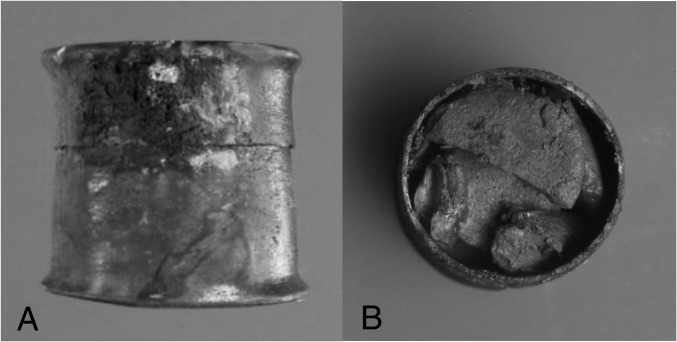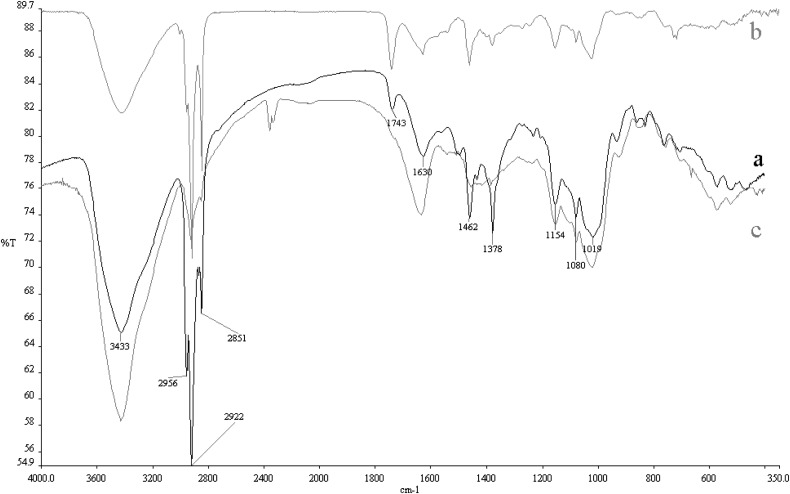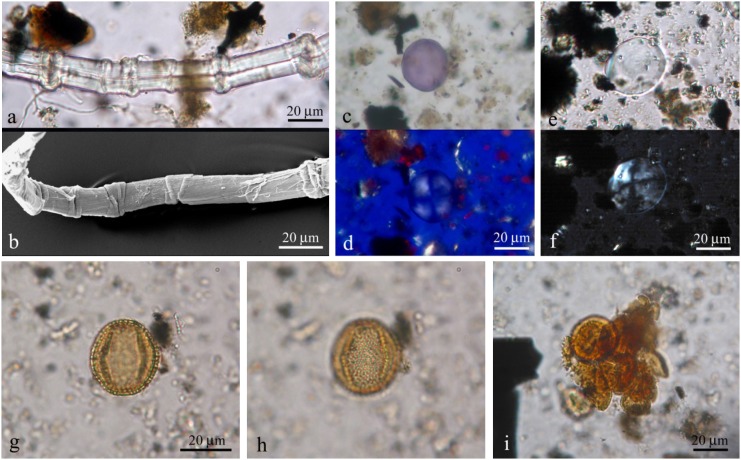Abstract
In archaeology, the discovery of ancient medicines is very rare, as is knowledge of their chemical composition. In this paper we present results combining chemical, mineralogical, and botanical investigations on the well-preserved contents of a tin pyxis discovered onboard the Pozzino shipwreck (second century B.C.). The contents consist of six flat, gray, discoid tablets that represent direct evidence of an ancient medicinal preparation. The data revealed extraordinary information on the composition of the tablets and on their possible therapeutic use. Hydrozincite and smithsonite were by far the most abundant ingredients of the Pozzino tablets, along with starch, animal and plant lipids, and pine resin. The composition and the form of the Pozzino tablets seem to indicate that they were used for ophthalmic purposes: the Latin name collyrium (eyewash) comes from the Greek name κoλλυ´ρα, which means “small round loaves.” This study provided valuable information on ancient medical and pharmaceutical practices and on the development of pharmacology and medicine over the centuries. In addition, given the current focus on natural compounds, our data could lead to new investigations and research for therapeutic care.
Keywords: archaeometry, archaeobotany, chemical analysis, mineralogical analysis, Etruscan shipwreck
In archaeology, the discovery of ancient medicines is very rare, as is knowledge of their chemical composition (1–3). Most information regarding such findings comes from ancient writers such as Theophrastus (371–286 B.C.), Pliny the Elder (first century A.D.), and Dioscorides (first century A.D.).
We present results combining chemical, mineralogical, and botanical investigations on the well-preserved contents of a tin pyxis. This pyxis was found onboard the Pozzino shipwreck discovered on the seabed of the Baratti Gulf (Fig. S1) at a depth of about 18 m near the remains of the Etruscan city of Populonia (Tuscany, Piombino, Italy) (4–6). The shipwreck was discovered in 1974 and the Soprintendenza per i Beni Archeologici della Toscana (archaeological authorities of Tuscany) undertook the first exploration in 1982 and archaeological excavation during 1989–1990. The ship consisted of a small hull (15–18 m long and about 3 m wide) preserved only in the central part and inclined in the direction east–west, with the stern probably facing west. It was dated to the second half of the second century B.C. (probably 140–130 B.C.) on the basis of the archaeological findings. At that time, Populonia was of primary importance along the sea-trade routes between the West and East, and this shipwreck bears witness to the republican trades across the Mediterranean Sea. Many interesting objects were found during the excavations, among them Sirian-Palestinian glass bowls, still stacked; West-Slope ware from Pergamon; some lagynoi; Rodian amphoras for wine transport; lamps of Ephesian origin; several tin and bronze vessels, such as one-handled jugs (one with a filter spout); oinochoai with trefoil mouths; ladles; and one inkwell, all of which came from the same geographical area. Such objects suggest that the ship, or at least a great part of its cargo, came from the east, probably the Greek coasts or islands. It is very likely that the ship was first equipped in the free harbor of the island of Delos (4, 5). The cargo also included medical equipment: numerous tin pyxides and 136 wooden vials were found close to an iron lock from a wooden box that had been completely destroyed. The small cylindrical vials were made of boxwood (Buxus sempervirens L.). They were 5–6 cm high and about 2 cm in diameter. Most of them were equipped with their own covers, often short and conical. These objects were originally probably kept inside the box, together with a small stone mortarium, a bronze cupping vessel, and an iron probe (4, 5). The cupping vessel had a peculiar shape that was typical of a medical tool used for bloodletting or as an instrument to apply hot air to soothe aches (4, 5). These findings suggest that a physician was traveling by sea with his professional equipment.
X-rays highlighted regularly stratified contents inside one of the tin pyxides (A/6) (Fig. 1). Inside the pyxis were five discoid tablets. They were gray, subcircular, and measured ∼4 cm in diameter, with a maximum thickness of 1 cm (Fig. 2 A and B). Careful examination of one of the tablets showed an impression on its surface left by pressure from some kind of fabric (Fig. 2C).
Fig. 1.
The A/6 pyxis before it was opened (A) and the pyxis showing its contents (B).
Fig. 2.
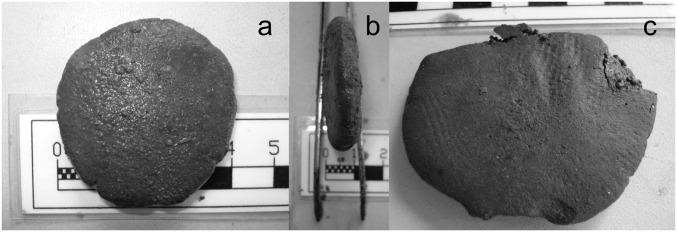
(A) The front and (B) profile of a tablet found in the A/6 pyxis. (C) Impression on the surface of the tablet left by pressure from some kind of fabric.
Results
To characterize the components of the tablets, some fragments sampled from a broken tablet were divided into subsamples. After preliminary micromorphological examination by light (LM) and scanning electron microscope (SEM), the identification of the inorganic and organic components were carried out with chemical and mineralogical analyses of the subsamples [scanning electron microscope in combination with energy-dispersive X-ray spectroscopy (SEM-EDX), Fourier transform infrared spectroscopy (FTIR), X-ray powder diffraction (XRD), and gas chromatography/mass spectrometry (GC/MS)]. In addition, botanical analysis was used to detect the presence of plant remains and their possible origin.
SEM-EDX analysis revealed Zn as the main element (75%), along with Si (9%) and Fe (5%) as minor inorganic elements. FTIR and XRD highlighted the presence of hydrozincite [zinc hydroxycarbonate, Zn5(CO3)2(OH)6], smithsonite (Zn carbonate, ZnCO3), and hematite (Fe2O3). In particular, in the FTIR spectrum (Fig. S2) hydrozincite was recognized by the peaks at 3,377 (O–H stretching), 1,560, 1,510, 1,385 (CO32− asymmetric stretching ν3), 832 (OCO out-of-plane bending ν2), and 708 cm−1 (asymmetric in-plane OCO bending ν4) and smithsonite by the peaks at 1,424 (CO32− asymmetric stretching ν3), 867 (OCO out-of-plane bending ν2), and 738 cm−1 (asymmetric in-plane OCO bending ν4). Inorganic components accounted for more than 80% of the total, as evaluated from a gravimetric determination of a portion of the tablet, dissolved in a 10% (vol/vol) HCl–water solution.
The FTIR analysis of the organic components pointed out to the presence of starch (Fig. 3), whose identification was based on peaks at 3,433, 2,956–2,851, 1,630, 1,460–1,378, and 1,154–1,019 cm−1 owing to O–Η stretching, C–H stretching, O–Η bending, C–H bending, and C–O stretching, respectively. This result was experimentally confirmed by the FTIR analysis of wheat flour, first boiled in water and then dried. GC/MS analysis of the soluble and saponifiable organic components (Fig. 4) highlighted a mixture of vegetal and animal acyl lipids and beeswax (7, 8). Beeswax was clearly recognized by the high abundance of palmitic acid (C16:0) together with the presence of long-chain n-alcohols containing 24–32 carbon atoms, long-chain linear saturated monocarboxylic fatty acids containing 20–28 carbon atoms, and 14-hydroxyhexadecanoic and 15-hydroxyhexadecanoic acids. The presence of linear and branched monocarboxylic fatty acids with 15 and 17 carbon atoms along with cholesterol and cholestanol suggests an animal origin for the acyl lipids. Furthermore, owing to the identification of β-sitosterol and to the high abundance of oleic acid, it is possible to hypothesize that lipids of vegetal origin were admixed to beeswax and animal acyl lipids. The identification of dehydroabietic and 7-oxo-dehydroabietic acids indicated the presence of a Pinaceae resin (7–9). In addition, several phenathrenes were recognized in very small amounts, thus confirming the presence of vegetal charcoal, as also observed by SEM.
Fig. 3.
FTIR spectrum of (A) the organic components of the Pozzino tablet (black line) in comparison with the spectra (gray lines) derived respectively from (B) the wheat flour boiled in water and dried and (C) reference starch.
Fig. 4.
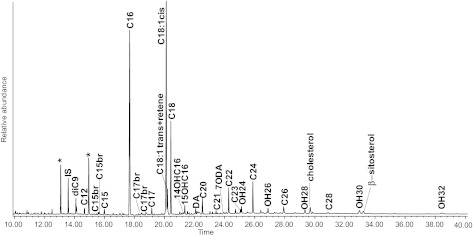
Total ion current (TIC) chromatogram of the trimethylsilylated hydrolysable and soluble components obtained by GC/MS. 7ODA, 7-oxo-didehydroabietic acid; AX, monocarboxylic fatty acids of chain length x; AXbr, branched monocarboxylic fatty acids of chain length x; AX:Y, monocarboxylic fatty acids of chain length x and degree of unsaturation y; DA, dehydroabietic acid; diAX, α,ω-dicarboxylic fatty acids of chain length x; IS, n-tridecanoic acid internal standard; OHx, n-alkanols of chain length x; XOHAX, hydroxy fatty acids of chain length x and with hydroxy group at position X.
Numerous plant remains were detected in the tablet by SEM and LM (Fig. 5), including fibers, starch grains, and pollen grains. Fibers were more numerous in the outer than in the inner parts of the sample. These fibers could be Linum blast fibers that were broken or cut (Fig. 5 A and B).
Fig. 5.
Plant remains. (A) Fiber of flax (LM). (B) Fiber of flax (SEM). (C) Starch grain (Lugol staining, LM). (D) The same starch grain at polarizing LM. (E and F) Starch grain at LM and polarizing LM. (G and H) Pollen grain of Olea europaea (LM: optical cross-section and exine surface focus). (I) Group of pollen grains (LM).
Starch grains of different sizes and shapes were also observed in the sample. The concentration of the well-preserved grains was ∼20,000 per gram. The large starch grains, 20–25 μm in size, had a circular-subcircular contour on the top and a lenticular contour on the sides (Fig. 5 C–F). They had evident linear hilum, a radially symmetrical extinction cross, with arms sometimes widened toward the ends, and barely visible lamellae; small dimples were occasionally detected on the surface. These features suggested that they were large starch grains from caryopses of the Triticeae tribe, possibly Triticum. Some large grains (main axis ≥27 μm) displayed faint or lost extinction crosses, lamellae, and hilum (Fig. 5E). This kind of damage is considered a marker of cooking (10) and may indicate boiling or baking for a short period.
Pollen grains were numerous, with a concentration of ∼1,400 grains per gram. At least 53 different pollen morphotypes were found. More than 40% of the entire pollen content was from Olea europaea (Fig. 5 G and H). The second most abundant grains, ∼13%, belonged to the Gramineae Avena-Triticum group. On the basis of the morphometric parameters and exine features, they probably belonged to Triticum (11, 12). Chenopodiaceae (5%) and Centaurea nigra (3.5%) pollen-type grains also were present in noticeable amounts. They occurred both singly or in groups and were poorly preserved.
The pollen of many other plants, such as Sanguisorba minor, Urtica dioica, Alnus glutinosa, and Cruciferae, that could have been used in ancient medicine, as reported by ancient writers (13), were found in the inner part of the tablet, ranging from 0.5 to 3% of the total pollen grains. Interestingly, excluding Olea and Gramineae, whose pollen may have had a different origin, the majority of the grains (about 60%) came from insect-pollinated plants, particularly Leguminosae and Compositae. This suggests that such grains may have come from a common origin such as a bee product, rather than from ingredients singularly and intentionally added to the medicine. This is also suggested by the presence of clumps of pollen, each consisting of grains belonging to different flowers that are commonly visited by bees (Fig. 5I).
Discussion and Conclusions
Hydrozincite and smithsonite were by far the most abundant ingredient of the Pozzino tablet. Although the active ingredient is not necessarily the most abundant, the efficacy of zinc compounds in treating human diseases, known since ancient times, suggests that zinc carbonate and hydroxycarbonate were the active compounds in the formulation of the Pozzino medicine. It is difficult to be sure which Zn compounds were used at the time of the Pozzino. Zinc minerals were generically referred to as “calamina,” a name denoting different combinations of silicate/carbonate/oxide, which could be found in nature, together with ores of other metals, such as Pb, Cu, Fe, or Ag (14). In therapy, great importance was attributed to zinc oxide, which was artificially obtained during the casting of copper from minerals also containing zinc ores. Pliny the Elder in Naturalis historia (ref. 15, p. 22) and Dioscorides in De materia medica (ref. 16, p. 732) described different qualities of cadmia collected from the vaults or walls of the furnaces during copper production. They wrote how this by-product was useful for preparing medicines for the eyes and for general dermatological purposes.
The linen fibers found inside the Pozzino tablets have not been found in other ancient medicines. The vegetal fibers could have been added to prevent breakage or crumbling of the tablets. Other plant macroremains in the Pozzino tablet included small charcoals. They could have been processing residues of some of the ingredients or have been intentionally added. In fact, black charcoal was found in collyrii from Lyon; however, its role as an active ingredient has not been ascertained (17).
Starch grains, probably heat-processed, were detected in the Pozzino tablet. Starch with well-preserved helical moieties (amylose) has been found as an ingredient of a Roman cosmetic dated to the second century A.D. (18).
Animal and vegetal lipids were also detected. In terms of the vegetal lipids that may have been added to the preparation, olive oil is a possibility. In the past, oleum acerbum, or “omphacium,” obtained by pressing unripened olives, was specifically used for perfumes and medicinal preparations (ref. 19, p. 60; and ref. 20, p. 145). The unripened olives’ surfaces might well have been contaminated by olive pollen, which was found in notable amounts.
In ancient times, plant resins played a prominent role owing to their many intrinsic properties. In the case of the Pozzino tablet, the pine resin may have slowed down the natural degradation (rancidity) of the oil because of its antioxidant properties, and it may have reduced microbial growth due to its antiseptic properties.
Finally, the Greek name κoλλυ´ρα, from which the Latin name collyrium derives (17), means “small round loaves,” highlighting that the shape itself of the Pozzino tablets is consistent with an ophthalmic use.
Methods
To characterizing the components of tablets, fragments were sampled from a broken tablet with a scalpel, divided into subsamples, and stored in glass vessels until the laboratory investigations were undertaken. After preliminary micromorphological examination, the subsamples were subjected to chemical and mineralogical analyses to identify the inorganic and organic components and botanical analysis to reveal the presence of plant remains.
The analysis of the inorganic component was carried out by means of SEM-EDX and FTIR spectroscopy, whereas the mineralogical phases were identified by XRD (the analytical procedure and instrumental parameters are reported in ref. 21). The organic content was characterized by FTIR (22) along with an analytical procedure based on GC/MS (the analytical method and instrumental parameters are reported in ref. 23).
In addition to the observations under LM and SEM, archaeobotanical analyses were performed on ∼1 g of the tablet. To take into account the contribution of a possible surface pollen contamination, about 0.5 g was accurately isolated from the inner part of the tablet and processed for pollen analysis; the other 0.5-g sample was taken from the outer part of the tablet and treated for performing starch and pollen analyses. Each aliquot was at first dissolved in a 10% (vol/vol) HCl–water solution, which dissolved the main components of the tablet, and washed in water.
To investigate plant remains, in particular fibers and starch analyses, the deposit was mounted in water and/or glycerol and examined under light microscope and polarizing microscope. Starch grains were also observed after iodine/potassium iodide staining. For pollen analysis, the residue was water-sieved (0.5-mm screen), subjected to acetolysis, and mounted in a 50% (vol/vol) glycerol–water solution.
Supplementary Material
Footnotes
The authors declare no conflict of interest.
This article is a PNAS Direct Submission.
This article contains supporting information online at www.pnas.org/lookup/suppl/doi:10.1073/pnas.1216776110/-/DCSupplemental.
References
- 1.Ribechini E, Modugno F, Pérez-Arantegui J, Colombini MP. Discovering the composition of ancient cosmetics and remedies: Analytical techniques and materials. Anal Bioanal Chem. 2011;401(6):1727–1738. doi: 10.1007/s00216-011-5112-2. [DOI] [PubMed] [Google Scholar]
- 2.Perez-Arantegui J, Ribechini E, Colombini MP, Escudero F. Characterisation of an ancient ‘chemical’ preparation: Pigments and drugs in the medieval Islamic Spain. J Archaeol Sci. 2011;38(12):3350–3357. [Google Scholar]
- 3.Stacey RJ. The composition of some Roman medicines: Evidence for Pliny’s Punic wax? Anal Bioanal Chem. 2011;401(6):1749–1759. doi: 10.1007/s00216-011-5160-7. [DOI] [PubMed] [Google Scholar]
- 4.Romualdi A. I materiali. In: Nicosia F, Romualdi A, editors. Relitto del Pozzino (B del Golfo di Baratti), Catalogo della mostra. Piombino 14-luglio-31 ottobre 1990. Italy: Edizioni Zeta, Florence; 1990. pp. 31–34. [Google Scholar]
- 5.Romualdi A, Firmati M. 1998. Memorie sommerse. Archeologia subacquea in Toscana, Catalogo della Mostra, Fortezza spagnola di Porto S. Stefano, 31 maggio 1997, eds Poggesi G, Rendini P (Laurium Editrice, Pitigliano, Italy), pp 184–192. Italian.
- 6.Ciabatti E. 1990. Relitto del Pozzino (B del Golfo di Baratti), Catalogo della Mostra. Piombino 14-Luglio-31 Ottobre 1990, eds Nicosia F, Romualdi A (Edizioni Zeta, Florence, Italy), pp 17–22. Italian.
- 7.Colombini MP, Modugno F. Organic Mass Spectrometry in Art and Archaeology. Chichester, UK: Wiley; 2009. [Google Scholar]
- 8.Ribechini E, Orsini S, Silvano F, Colombini MP. Py-GC/MS, GC/MS and FTIR investigations on Late Roman-Egyptian adhesives from opus sectile: New insights into ancient recipes and technologies. Anal Chim Acta. 2009;638(1):79–87. doi: 10.1016/j.aca.2009.02.004. [DOI] [PubMed] [Google Scholar]
- 9.Ribechini E, Modugno F, Colombini MP, Evershed RP. Gas chromatographic and mass spectrometric investigations of organic residues from Roman glass unguentaria. J Chromatogr A. 2008;1183(1–2):158–169. doi: 10.1016/j.chroma.2007.12.090. [DOI] [PubMed] [Google Scholar]
- 10.Henry AG, Hudson HF, Piperno DP. Changes in starch grain morphologies from cooking. J Archaeol Sci. 2009;36(3):915–922. [Google Scholar]
- 11.Andersen ST. Identification of Wild Grasses and Cereal Pollen. Copenhagen: Danmarks Geologiske Undersøgelse Årbog; 1979. pp. 69–92. [Google Scholar]
- 12.Beug HJ. 1961. Leitfaden der Pollenbestimmung für Mitteleuropa und angrenzende Gebiete [Pollen Guide for Central Europe and Adjacent Areas] (Gustav Fischer, Stuttgart). German.
- 13.Ciarallo A. 2009. Plants as a major element in the cultural framework of Pompeii. Plants and Culture: Seeds of the Cultural Heritage of Europe, eds Morrel J-P, Mercuri AM (Centro Europeo per i Beni Culturali Ravello, Edipuglia, Bari, Italy), pp 63–67.
- 14.Boni M, Large D. Nonsulfide zinc mineralization in Europe: An overview. Econ Geol. 2003;98:715–729. [Google Scholar]
- 15.Pliny the Elder, Storia Naturale, trans Barchiesi A 1988. (Giulio Einaudi, Torino, Italy). Book XXXIV, Chap 22, p 233. Italian.
- 16.Mattioli PA. 1645. I discorsi di M Pietro Andrea Matthioli Sanese (Marco Ginammi, Venice, Italy). Book V, Chap 43, pp 732–733. Italian.
- 17.Gourevitch D. Collyres romains inscrits. Hist Sci Med. 1998;XXXII(4):365–372. [PubMed] [Google Scholar]
- 18.Evershed RP, et al. Archaeology: Formulation of a Roman cosmetic. Nature. 2004;432(7013):35–36. doi: 10.1038/432035a. [DOI] [PubMed] [Google Scholar]
- 19.Pliny the Elder, Storia Naturale, trans Barchiesi A 1988. (Giulio Einaudi, Torino, Italy). Book XII, Chap 60, p 81. Italian.
- 20.Mattioli PA. 1645. I discorsi di M Pietro Andrea Matthioli Sanese (Marco Ginammi, Venice, Italy). Book I, Chap 117, p 145. Italian.
- 21.Giachi G, De Carolis E, Pallecchi P. Raw materials in Pompeian paintings: Characterisation of some colours from the archaeological site. Mater Manuf Process. 2009;24:1015–1022. [Google Scholar]
- 22.Colombini MP, Giachi G, Iozzo M, Ribechini E. An Etruscan ointment from Chiusi (Tuscany, Italy): Its chemical characterisation. J Archaeol Sci. 2009;36(7):1488–1492. [Google Scholar]
- 23.Ribechini E, Pérez-Arantegui J, Colombini MP. Gas chromatography/mass spectrometry and pyrolysis-gas chromatography/mass spectrometry for the chemical characterisation of modern and archaeological figs (Ficus carica) J Chromatogr A. 2011;1218(25):3915–3922. doi: 10.1016/j.chroma.2011.04.052. [DOI] [PubMed] [Google Scholar]
Associated Data
This section collects any data citations, data availability statements, or supplementary materials included in this article.



